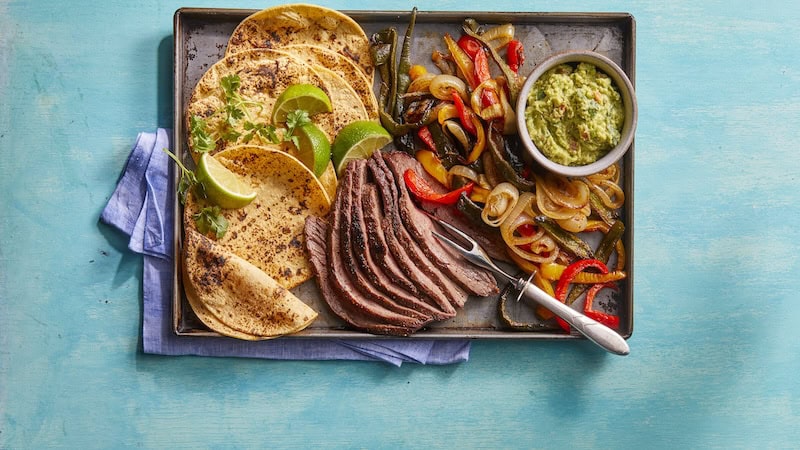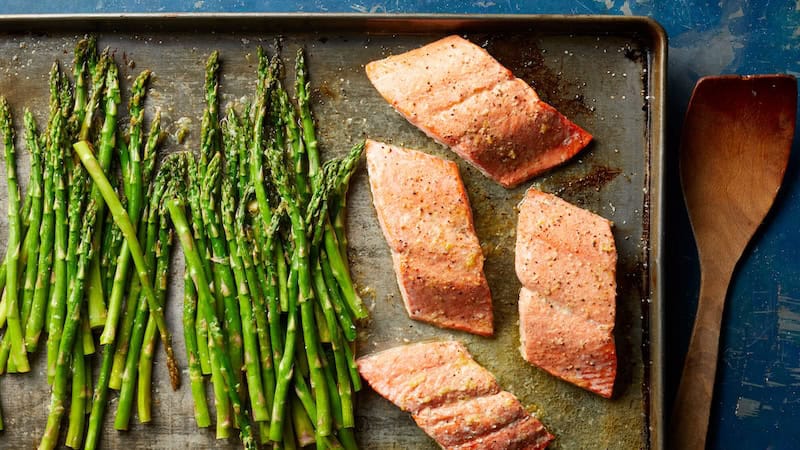Seafood Grilling Tips
A pro shares the secrets to success
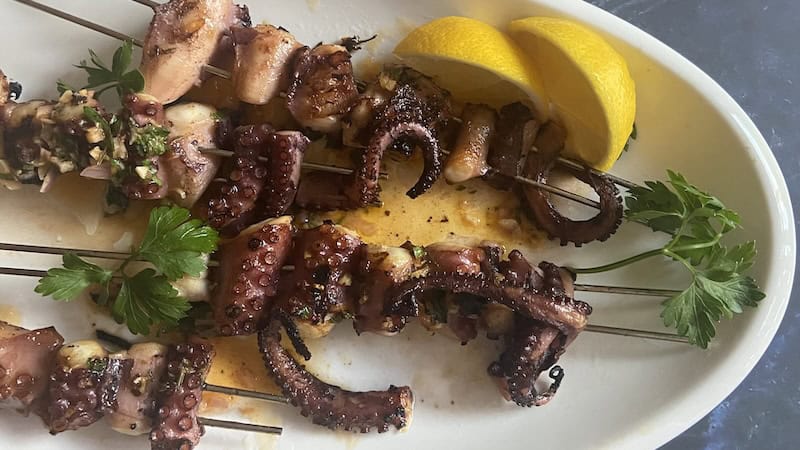
Grilling can enhance the flavor of so many foods, including seafood. Chef and cookbook author JeanMarie Brownson shares her seafood grilling tips plus recipes to make you a master chef at the grill.
A covered grill, fueled by charcoal or gas, just may be the perfect vehicle for cooking fish. From small whole trout or branzino to thick halibut steaks, the smoky flavor of hardwood pairs beautifully with all manner of seafood.
That doesn’t mean grilling fish is easy or foolproof. Most seafood proves expensive — overcooking can render it inedible and a real misfortune.
So, let’s talk about how to be successful.
Top seafood grilling tips
-
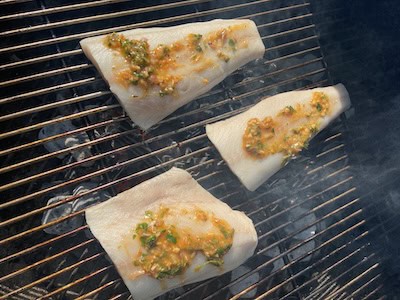
Grilled Sablefish with Seasoned Shallot Butter First, work with a covered grill to help control heat and prevent flare-ups. Always allow time to preheat the grill. Charcoal should burn until embers glow red and are covered in gray ash. Gas grills need to be preheated to prevent sticking and allow for maximum defined grill marks, which equal flavor.
- Second, a preheated grill grate prevents sticking. Always clean the grates — it’s easiest to do this when they are hot. Clean grill grates help prevent sticking. Never oil the grill grates–rather, oil the fish instead.
- Don’t overdo the smoke; most seafood needs just a minimum of added smoke flavor. Add just a few soaked wood chips to the coals or the smoker basket of a gas grill.
- Use moderately high heat for seafood, but have a cooler section of the grill available if the browning gets away from you.
- Have the fish sit at room temperature for 10 to 20 minutes before cooking.
- Calculate 8 to 10 minutes of grill time per inch of fish. In general, I set the timer for the first side to be a minute or two longer than the total cooking time. For example, to cook a 1-inch thick piece of halibut, I leave it untouched on the grill for 5 minutes. Then flip it for the remaining cooking time of 3 to 5 minutes.
- Do not fuss – flipping food over and over again on the grill decreases the chance for beautiful browning (plus you lose grill heat every time you open the grill) and increases the chance of sticking.
- Grilling skin-on fish fillets means no flipping is required. The skin acts as a natural insulator for a moist interior. A bonus? Crispy fish skin tastes marvelous.
- Skewer smaller fish, shrimp and scallops to make them expedient to turn.
- When the grill is properly heated, and the fish lightly oiled, the fish will release itself from the grill grates when it’s finished cooking. Use a thin, metal spatula to gently loosen and remove the fish.
- Always let the cooked fish rest a couple of minutes before eating to allow juices to settle and finish cooking.
Wild-caught Alaskan sablefish, also known as black cod, grills beautifully. Its rich, buttery texture stays moist even with the dry heat. They are usually sold as skin-on fillets, and I grill it, skin side down with every intention to enjoy the crispy skin. A complex shallot and garlic-infused butter is all that’s needed to make a restaurant-quality piece of fish.
When I can find small, wild-caught whole octopus at my local fish market or Japanese market, I grab it for summer grilling. Most markets sell octopus that has been previously frozen; ask them to clean it for you. At home, rinse the octopus well. Then simmer it in seasoned salted water until tender when pierced with a fork, about 1 hour. To ensure tenderness, allow the octopus to cool slowly in the cooking water. Then, remove it (save the flavorful broth) and chill the octopus completely.
For skewers, cut the tentacles into 1-inch chunks and skewer them on thin metal skewers or soaked bamboo skewers. Grill directly over the heat, basting often with the seasoned butter mixture until lightly charred on all sides, about 4 minutes total.
Grilled Sablefish with Seasoned Shallot Butter
Makes 4 servings
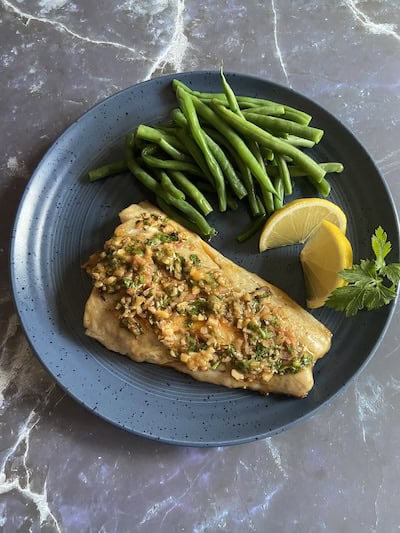
Note: This recipe also works well with small rainbow trout or branzino. Open up the whole fish so you can cook it skin side down.
Ingredients:
- 4 fish fillets with skin, each about 10 ounces, such as wild-caught Alaskan sablefish
- Vegetable oil in a spray bottle
- 2 small lemons, halved
- About 6 tablespoons seasoned shallot butter, see recipe
- Chopped fresh chives, for garnish
Directions:
- Preheat a gas grill to medium-hot or prepare a charcoal grill and let coals burn until covered with gray ash. Turn off burners on one side of the gas grill or arrange coals at sides of charcoal grill. The idea is to have two areas for cooking; one directly over the heat and the other away from the heat. Heat the grill grate before adding the food.
- Spray the fish’s skin side and the lemons’ cut side with oil. Put the fish, skin side down on the heated grill grates. Baste generously with some of the butter mixture. Put the lemon halves, cut side down on the grill. Cover the grill and cook, without turning for 5 minutes.
- Baste the fish again with the butter mixture. Check the lemons, they are done when soft and lightly charred. If the lemons are done, move them to the cooler portion of the grill. Continue to cook the fish until it nearly flakes easily, about 3 minutes more.
- Carefully transfer fish, using a thin metal spatula, to a serving platter. Add lemons to the platter. Spoon any remaining butter mixture over all. Sprinkle with chives. Serve.
Grilled Octopus with Seasoned Shallot Butter
Makes 2 appetizer servings
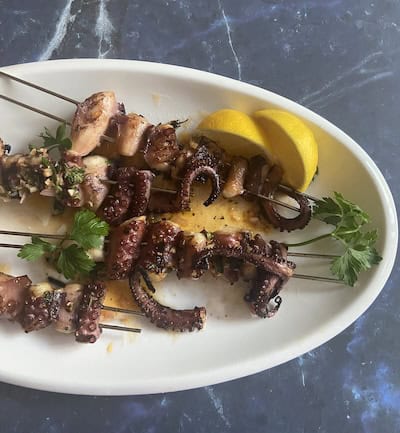
Note: The flavorful, mildly sweet broth that results from simmering an octopus proves a bonus to other dishes such as seafood stew, a seafood risotto or fish curry. After straining, package the broth in 1- or 2-cup containers and store in the freezer.
[entree-grilling-octopus-20240722]
Ingredients:
- 1 small whole wild-caught octopus, cleaned, about 1 1/2 pounds
- 1 teaspoon salt
- 2 cloves garlic, crushed
- 1 or 2 bay leaves
- 1/2 teaspoon black peppercorns
- 1/4 teaspoon crushed red pepper flakes
- Olive oil in a spray bottle
- 2 or 3 tablespoons Seasoned shallot butter for seafood, see recipe
- Parsley sprigs and lemon wedges, for garnish
Directions:
- Rinse octopus well. Put 2 1/2 quarts cold water into a large saucepan. Add salt, garlic bay leaves, peppercorns and red pepper flakes. Add the octopus. Heat over medium heat to a simmer.
- Reduce heat to low, partly cover the pot and simmer, stirring occasionally, until octopus tentacles are tender when pierced with the tip of a knife, 50 to 60 minutes. Take care not to let the water boil hard; aim for a low simmer with small bubbles breaking on the surface.
- Turn off the heat and let octopus cool in the water for about 1 hour. Remove octopus with tongs to a container. Refrigerate covered for up to two days. Strain the broth and save for another use. (Broth can be frozen up to several months.)
- Preheat a gas grill to medium-hot or prepare a charcoal grill and let coals burn until covered with gray ash. Turn off burners on one side of the gas grill or arrange coals at sides of charcoal grill. The idea is to have two areas for cooking; one directly over the heat and the other away from the heat. Heat the grill grate before adding the food.
- Cut tentacles into 1 1/2 -inch pieces and thread onto 4 thin metal or soaked bamboo skewers. (Discard the head). Spray lightly with oil.
- Place skewers on grill directly over the heat. Cover the grill and cook 2 minutes. Flip the skewers. Grill to brown the other side, 1 to 3 minutes.
- Remove octopus skewers to a platter and dollop a little butter on top to melt it. Serve hot garnished with parsley and lemon wedges.
Seasoned Shallot Butter
Makes about 1 cup
Note: Make your own seasoning for this butter or substitute bottled Cajun seasoning or Old Bay.
Ingredients:
- 1/2 cup (1 stick) unsalted butter
- 2 shallots, finely chopped (or white section of 2 green onions)
- 1 tablespoon seafood seasoning, see recipe
- 3 cloves garlic, finely chopped
- 1/4 cup chopped flat-leaf parsley
- 1 small lemon
Directions:
- Put butter, shallots, seasoning and garlic in a small bowl. Cover and microwave on high (100 percent power) until butter is melted.
- Stir in finely grated rind from of 1/2 of the lemon and juice from the whole lemon. Stir in parsley. Use warm or at room temperature. (Mixture can be refrigerated, covered, up to several days.)
Seafood Seasoning
Makes 1/4 cup
Ingredients:
- 1 tablespoon table salt
- 2 teaspoons sweet paprika
- 1 1/2 teaspoons each: garlic powder, dried basil
- 1 teaspoon each: dried thyme, freshly ground black pepper
- 3/4 teaspoon dried oregano
- 1/4 teaspoon cayenne pepper
Directions:
Mix everything in a small container with a tight-fitting lid.
JeanMarie Brownson is a James Beard Award-winning author and the recipient of the IACP Cookbook Award for her latest cookbook, “Dinner at Home.” JeanMarie, a chef and authority on home cooking, Mexican cooking and specialty food, is one of the founding partners of Frontera Foods. She co-authored three cookbooks with chef Rick Bayless, including “Mexico: One Plate at a Time.” JeanMarie has enjoyed developing recipes and writing about food, travel, and dining for more than four decades.
©2024 JeanMarie Brownson. Distributed by Tribune Content Agency, LLC.
Also from JeanMarie Brownson, this recipe for a satisfying meatless burger. Really!
As an Amazon Associate, Boomer Magazine earns from qualifying purchases of linked books and other products.
